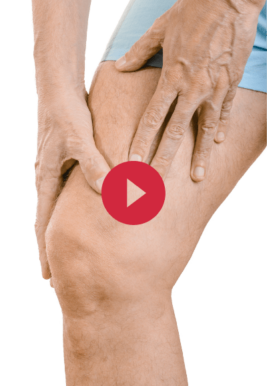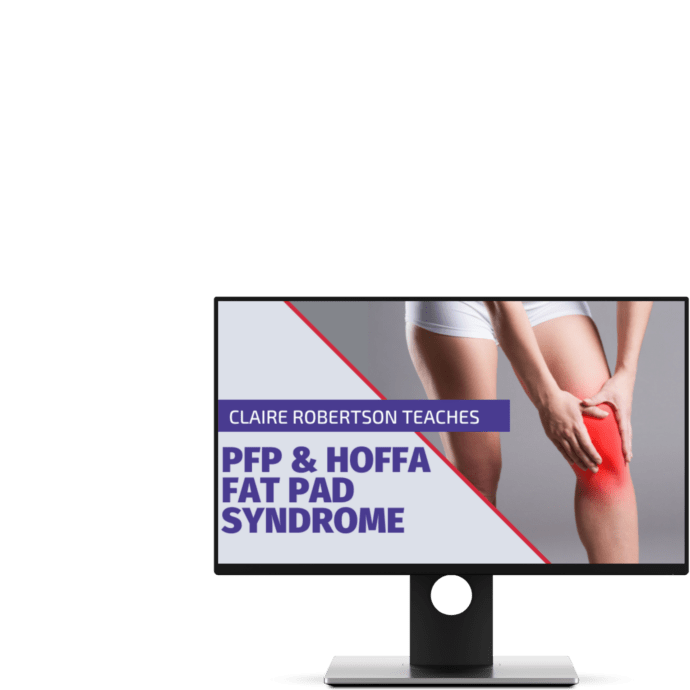Infrapatellar Fat Pad Syndrome | Diagnosis & Treatment

Infrapatellar Fat Pad Syndrome | Diagnosis & Treatment
Introduction & Pathomechanism

The infrapatellar fat pad is an intracapsular and extrasynovial adipose tissue occupying the anterior knee joint. It is bordered anteriorly by the patellar tendon and the joint capsule, superiorly by the inferior pole of the patella, inferiorly by the proximal tibia and the deep infrapatellar bursa, and posteriorly by the joint synovium. As it is highly vascularized and innervated, impingement of the infrapatellar fat pad is a potential source of nociception causing anterior knee pain that is often overlooked.
Pathomechanism
Biomechanically, the fat pad is a mobile structure that can help to stabilize the patella and the patellar tendon and prevents pinching of the synovial membrane.In 1904, Hoffa was the first to describe an isolated impingement of the fat pat as an inflammatory hypertrophy, and hyperplasia of the adipose tissue characterized by fibrosis and calcifications. These changes can either result from trauma as well as chronic repetitions like those experienced in regular sporting activities.
Follow a course
- Learn from wherever, whenever, and at your own pace
- Interactive online courses from an award-winning team
- CEU/CPD accreditation in the Netherlands, Belgium, US & UK
Clinical Picture & Examination
Patients with Hoffa’s syndrome present with burning or aching anterior knee pain with variable duration of symptoms from weeks to even years. Oftentimes, swelling on both sides of the patella is observed even in the absence of arthritis. On physical examination pain and tenderness around the patellar tendon, usually near the inferior pole of the patella is one of the hallmark signs of the pathology. Range of motion is limited to some extent, with most studies reporting pain at end-range extension. Pain is then also often aggravated by full extension and dynamic extension such as during stair climbing or a prolonged period of flexion. A test that can be used to diagnose the syndrome is Hoffa’s test. Similar to other body regions and pathologies, there is only a weak association between abnormalities seen on imaging techniques and clinically diagnosed Fat pad syndrome. Therefore, the diagnosis should not be solely based on medical imaging but is rather a clinical diagnosis.
Physical Examination
THE ROLE OF THE VMO & QUADS IN PFP

Follow a course
- Learn from wherever, whenever, and at your own pace
- Interactive online courses from an award-winning team
- CEU/CPD accreditation in the Netherlands, Belgium, US & UK
Treatment
Although successful management is reported with physiotherapy treatment, there is only anecdotal evidence from case studies that support different approaches. Recommendations range from closed-chain quadriceps exercises and gluteus medius training to bracing and stretching. Initially, it is recommended to desensitize the sensitive fat pad, which can be achieved by avoidance of hyperextension by making sure the knees are not in a locked back position during standing, icing and taping. In case conservative therapy fails, patients may benefit from surgical fat pat resection.
References
Follow a course
- Learn from wherever, whenever, and at your own pace
- Interactive online courses from an award-winning team
- CEU/CPD accreditation in the Netherlands, Belgium, US & UK
Increase Your Treatment Success in Patients with Knee Pain


What customers have to say about this online course
- Esra06/02/25Leuk en nuttig! Leuke cursus. Leuke afwisseling tussen tekst, video en toetsjes. Prettig dat de tekst in het Nederlands was.Linda Valk01/01/25Pfp syndroom cursus Hele fijne cursus, met duidelijke uitleg, zowel theoretisch als praktisch duidelijk.
- Erik Plandsoen31/12/24PFP & Hoffa fat pad syndrome Hele fijne cursus, met duidelijke uitleg, zowel theoretisch als praktisch duidelijke oefeningen.Anneleen Peeters22/12/24Great! Super interesting and insightful. Definitely a great tool to freshen up and expand on previous knowledge.
- Ronald Dols13/12/24Top cursus Mooie holistische benadering van een veelvoorkomend probleem.Olivier21/11/24Goede cursus! Hele goede cursus!
- Berfin Karagecili03/09/24Patellafemoraal pijn en fat pad syndroom Patellafemoraal pijn en fat pad syndroom
Hele duidelijke uitleg met instructie video’s. de tussentijdse toetsen waren ook handig om zo 100% uit je stof te kunnen halen.Martijn de Bruijn24/05/24PATELLOFEMORAL PAIN & FAT PAD SYNDROME It was a great course by Claire!! Nice explanation of the examination and treatment modalities.
Also the sport specific parts were very helpful. - Jean-Christophe Di Ruggerio04/03/24PATELLOFEMORAL PAIN & FAT PAD SYNDROME Great course with a knee expert!Seppe van den Audenaerde09/12/23PATELLOFEMORAL PAIN & FAT PAD SYNDROME GREAT COURSE THAT OPENED MY VIEW ON KNEE PAIN
Because of the way Claire looks at the knee joint and its surrounding joints, I learned a lot and it opened my eyes. Will look into her other courses for sure! - Alvin Chi24/07/23PATELLOFEMORAL PAIN & FAT PAD SYNDROME BEST PFPS RESOURCE I HAVE FOUND
I cannot recommend this course enough. I stumbled upon this course through the physiotutors podcast, and Claire’s episode on there intrigued me enough to purchase the course. As someone who treats PFPS every day, I have yet to find a resource that tries to personalize treatment for the patient rather than broadly treating all patients the same. Claire goes into detail on how physical exam findings lead to different treatment options. I wish this course was available 10 years ago. I highly recommend this course and hope Claire continues to contribute more courses on physiotutors!Cesare Cambi15/06/23PATELLOFEMORAL PAIN & FAT PAD SYNDROME COURSE ABSOLUTE AMAZING
The course has given me a very deep and practical insight over the PFPS’ patients. it was full of nice and important clinical and practical tips for everyday usage, thing that I really enjoyed and appreciated
I personally liked the most the sections regarding the assessment strategies and the brace and taping’s techniques, but overall a must-do course on for anyone interested in improving his/her skills in the treatment of Knee pain. - Lorna Thornton-McCullagh14/06/23PATELLOFEMORAL PAIN & FAT PAD SYNDROME THANK GOODNESS FOR CLAIRE PATELLA
What a brilliant course. A colleague had attended her course and recommended it to me- I never fancied attending London so when it came on line I grabbed the opportunity. Claire P always presents complicated material clearly and thoroughly without the normal physiotherapist pomp and circumstance. This course has been well researched with up to date evidence and well conveyed- THANK GOODNESS FOR CLAIRE PATELLAGeorge Hill12/05/23PATELLOFEMORAL PAIN & FAT PAD SYNDROME Excellent course by Claire Robertson, I thoroughly enjoyed it. Learned so much!. Well done physiotutors, keep up the great work you guys are doing. - Hannah Toppets06/12/22PATELLOFEMORAL PAIN & FAT PAD SYNDROME PFP & FAT PAD SYNDROME
Great course with nice video’s and clear info on the objects. Also nice to have a little quiz after each chapter. Nice to know how to tape and sport-specific rehab.



